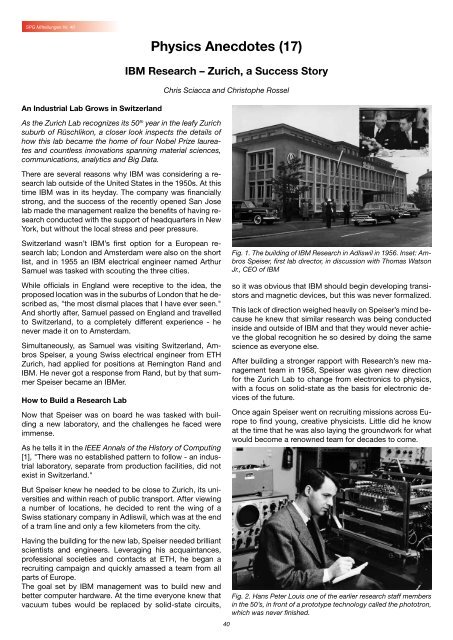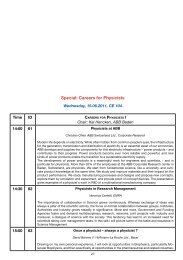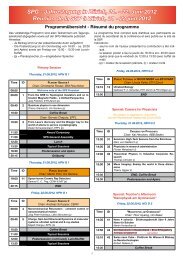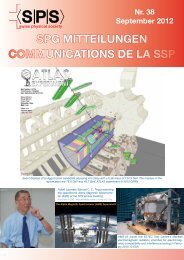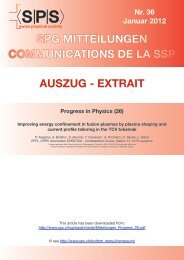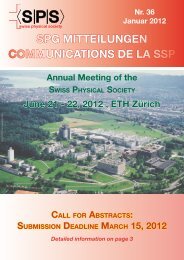spg mitteilungen communications de la ssp - Schweizerische ...
spg mitteilungen communications de la ssp - Schweizerische ...
spg mitteilungen communications de la ssp - Schweizerische ...
Create successful ePaper yourself
Turn your PDF publications into a flip-book with our unique Google optimized e-Paper software.
SPG Mitteilungen Nr. 40<br />
An Industrial Lab Grows in Switzer<strong>la</strong>nd<br />
As the Zurich Lab recognizes its 50 th year in the leafy Zurich<br />
suburb of Rüschlikon, a closer look inspects the <strong>de</strong>tails of<br />
how this <strong>la</strong>b became the home of four Nobel Prize <strong>la</strong>ureates<br />
and countless innovations spanning material sciences,<br />
<strong>communications</strong>, analytics and Big Data.<br />
There are several reasons why IBM was consi<strong>de</strong>ring a research<br />
<strong>la</strong>b outsi<strong>de</strong> of the United States in the 1950s. At this<br />
time IBM was in its heyday. The company was financially<br />
strong, and the success of the recently opened San Jose<br />
<strong>la</strong>b ma<strong>de</strong> the management realize the benefits of having research<br />
conducted with the support of headquarters in New<br />
York, but without the local stress and peer pressure.<br />
Physics Anecdotes (17)<br />
IBM Research – Zurich, a Success Story<br />
Chris Sciacca and Christophe Rossel<br />
Switzer<strong>la</strong>nd wasn’t IBM’s first option for a European research<br />
<strong>la</strong>b; London and Amsterdam were also on the short<br />
list, and in 1955 an IBM electrical engineer named Arthur<br />
Samuel was tasked with scouting the three cities.<br />
Fig. 1. The building of IBM Research in Adliswil in 1956. Inset: Ambros<br />
Speiser, first <strong>la</strong>b director, in discussion with Thomas Watson<br />
Jr., CEO of IBM<br />
While officials in Eng<strong>la</strong>nd were receptive to the i<strong>de</strong>a, the<br />
proposed location was in the suburbs of London that he <strong>de</strong>scribed<br />
as, "the most dismal p<strong>la</strong>ces that I have ever seen."<br />
And shortly after, Samuel passed on Eng<strong>la</strong>nd and travelled<br />
to Switzer<strong>la</strong>nd, to a completely different experience - he<br />
never ma<strong>de</strong> it on to Amsterdam.<br />
Simultaneously, as Samuel was visiting Switzer<strong>la</strong>nd, Ambros<br />
Speiser, a young Swiss electrical engineer from ETH<br />
Zurich, had applied for positions at Remington Rand and<br />
IBM. He never got a response from Rand, but by that summer<br />
Speiser became an IBMer.<br />
How to Build a Research Lab<br />
Now that Speiser was on board he was tasked with building<br />
a new <strong>la</strong>boratory, and the challenges he faced were<br />
immense.<br />
As he tells it in the IEEE Annals of the History of Computing<br />
[1], "There was no established pattern to follow - an industrial<br />
<strong>la</strong>boratory, separate from production facilities, did not<br />
exist in Switzer<strong>la</strong>nd."<br />
But Speiser knew he nee<strong>de</strong>d to be close to Zurich, its universities<br />
and within reach of public transport. After viewing<br />
a number of locations, he <strong>de</strong>ci<strong>de</strong>d to rent the wing of a<br />
Swiss stationary company in Adliswil, which was at the end<br />
of a tram line and only a few kilometers from the city.<br />
Having the building for the new <strong>la</strong>b, Speiser nee<strong>de</strong>d brilliant<br />
scientists and engineers. Leveraging his acquaintances,<br />
professional societies and contacts at ETH, he began a<br />
recruiting campaign and quickly amassed a team from all<br />
parts of Europe.<br />
The goal set by IBM management was to build new and<br />
better computer hardware. At the time everyone knew that<br />
vacuum tubes would be rep<strong>la</strong>ced by solid-state circuits,<br />
40<br />
so it was obvious that IBM should begin <strong>de</strong>veloping transistors<br />
and magnetic <strong>de</strong>vices, but this was never formalized.<br />
This <strong>la</strong>ck of direction weighed heavily on Speiser’s mind because<br />
he knew that simi<strong>la</strong>r research was being conducted<br />
insi<strong>de</strong> and outsi<strong>de</strong> of IBM and that they would never achieve<br />
the global recognition he so <strong>de</strong>sired by doing the same<br />
science as everyone else.<br />
After building a stronger rapport with Research’s new management<br />
team in 1958, Speiser was given new direction<br />
for the Zurich Lab to change from electronics to physics,<br />
with a focus on solid-state as the basis for electronic <strong>de</strong>vices<br />
of the future.<br />
Once again Speiser went on recruiting missions across Europe<br />
to find young, creative physicists. Little did he know<br />
at the time that he was also <strong>la</strong>ying the groundwork for what<br />
would become a renowned team for <strong>de</strong>ca<strong>de</strong>s to come.<br />
Fig. 2. Hans Peter Louis one of the earlier research staff members<br />
in the 50’s, in front of a prototype technology called the phototron,<br />
which was never finished.


